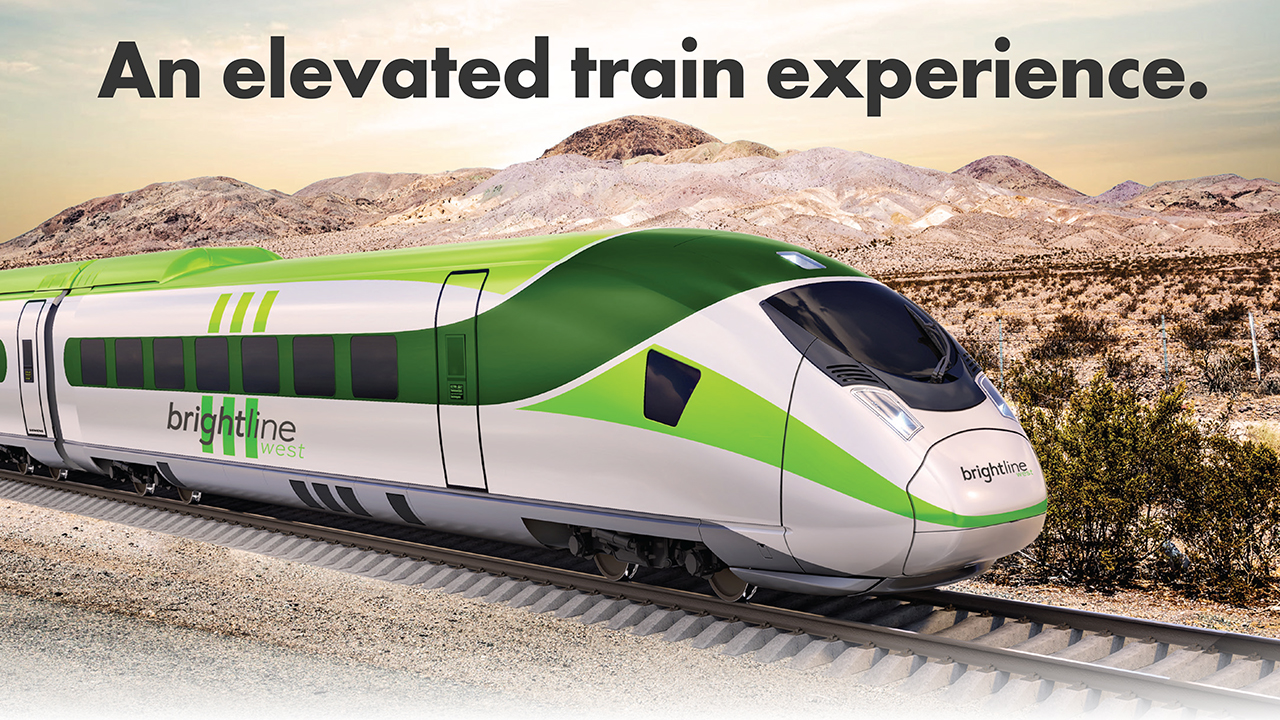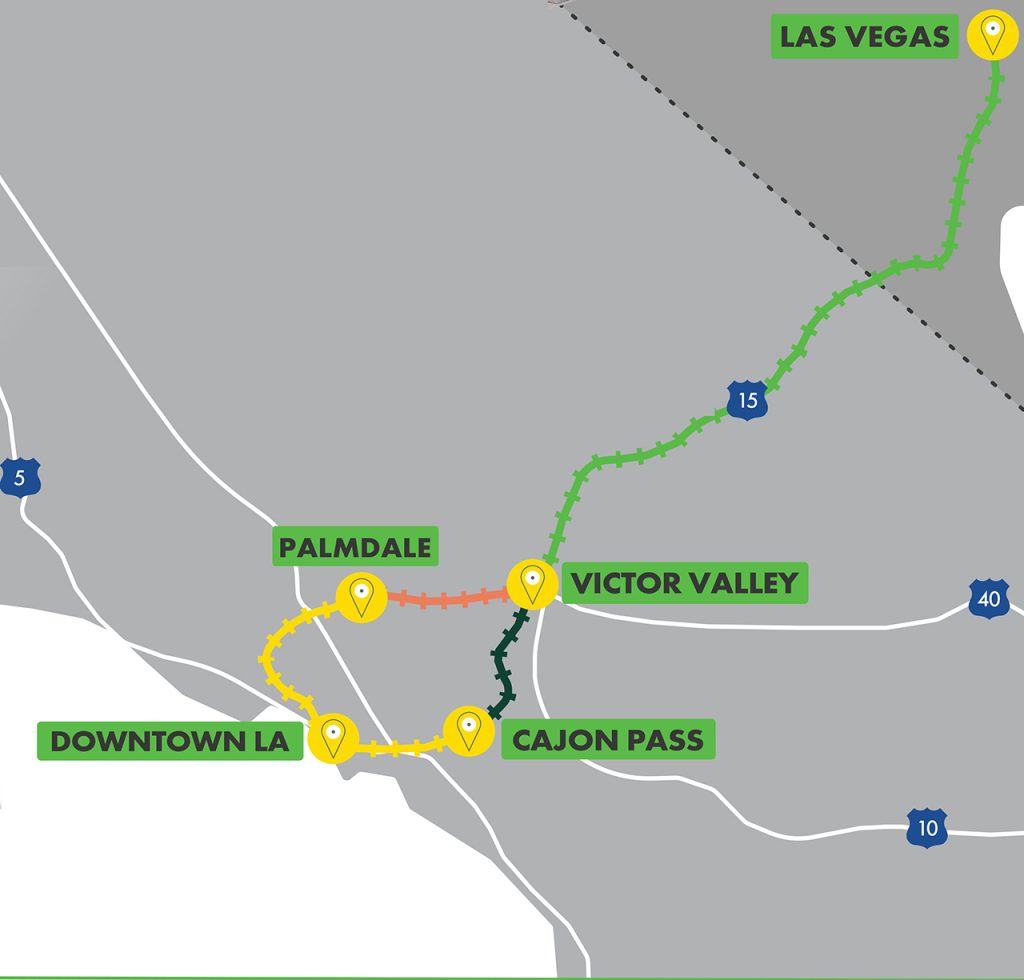
Brightline West Makes Progress
Written by David Peter Alan, Contributing Editor
Brightline West, the planned private-sector high-performance passenger railroad, is moving toward its goals of bringing passengers to Las Vegas and giving them a way to get there from Los Angeles. The railroad announced that plans are now set to bring its trains into Rancho Cucamonga, a community on Metrolink’s San Bernardino line, for a connection to Los Angeles Union Station.
Brightline hopes that the FRA will approve an environmental permit for that part of the route by the end of this year— a step toward opening the entire line, which company officials hope will take place in about 3½ years, an ambitious time frame for building a railroad complete with tracks and overhead catenary for power.

Mick Akers reported the development in the January 24 edition of the Las Vegas Review-Journal in a story headlined “Edens says that the Brightline high-speed rail project is at the ‘1-yard line’” and found at https://www.reviewjournal.com/news/news-columns/road-warrior/edens-says-brightline-high-speed-rail-project-is-at-the-1-yard-line-2518090/. He began his report with a question: “Could 2022 finally be the year construction on the long-discussed high-speed train between Las Vegas and Southern California gets under way?” The headline referred to Wes Edens, CEO of Fortress Investment Group, which owns Brightline West and the original Brightline, the railroad now running in Florida between Miami and West Palm Beach on Florida East Coast Railroad (FEC) tracks and building an extension of its line northward to Cocoa and then westward to Orlando Airport.
Akers reported: “Edens knows this project has been ongoing for more than a decade but he said the most significant strides have been made since Brightline came into the mix, getting it close to shovel-ready. A train system that was originally thought to be Vegas to Victorville, in the middle of the desert, is now, all the way to L.A. … I think that is a game-changer.”
Before Brightline became involved in 2018, plans only called for the line to run between Apple Valley and Las Vegas, without the segment to Rancho Cucamonga that Brightline West now plans to build. Planners and rider-advocates had criticized the former concept as ignoring the Los Angeles region with its millions of residents, many of whom depend on transit, a lifestyle that is now feasible due to the remarkable and continuing growth of the city’s and region’s transit systems over the past 30 years.
Alan Ohnsman reported in Forbes on Jan. 24: “Beyond Brightline West and Florida, Eden’s plan is to build passenger lines connecting other large cities that are between 200 miles to 300 miles apart, distances that are often too far to drive and too close to fly. To hold down costs, it also seeks to build tracks adjacent to existing highways—at ground level and not elevated—as it’s doing in Florida and intends to do in California and Nevada.”
With respect to Brightline West, the company hopes to break ground about one year from now. The required permit will cover the portion of line from Rancho Cucamonga to Victor Valley Station, a location in Apple Valley north of Victorville (the Cajon Pass Project, which will be 49 miles long). The FRA already issued a Record of Decision (ROD) for the segment from there to Las Vegas (the High Desert Project, 186 miles long) before Florida’s Brightline took over the proposed railroad. During its earlier history, it started as DesertXpress in 2005, and became XpressWest in 2012.
Current plans call for the entire line to open all at once, and all of it will be newly constructed railroad. Those plans also include a two-seat ride between the gambling mecca and the City of Angels, with adjacent stations at Rancho Cucamonga at a transit hub that will be established there for Brightline West, Metrolink trains and local buses. The proposed schedule calls for 25 daily round trips, leaving 45 minutes apart. Travel time for the 235-mile journey would be two hours, making the average speed about 115 mph. The top speed will be 180 mph. There are also plans to build two intermediate park-and-ride stations, at Hesparia and the previously-mentioned Victor Valley Station at Apple Valley.
Brightline West is not currently contemplating through-running on the Metrolink line (historically part of the Santa Fe), but a Metrolink schedule designed to offer a quick connection at Rancho Cucamonga to every train to Las Vegas would give all of that line’s riders a far-more-robust service than any regional rail line in southern California has ever offered. The current Metrolink schedule, which became effective on Oct. 25, offers 15 trains in each direction (one of which runs express) on weekdays, nine on Saturdays and seven on Sundays—more service than any other Metrolink line offers. The trip on Metrolink takes about 75 minutes.
When the new line enters service, it will fill a gap in the nation’s passenger rail network that has existed since May 1997. That was when Amtrak discontinued the Desert Wind, a train between Los Angeles and Salt Lake City that stopped at Las Vegas and connected with the California Zephyr, which still runs between Chicago and the Bay Area. The station in Las Vegas will be located on Las Vegas Boulevard at Warm Springs Road, with local bus access to the Strip and downtown locations like Fremont Street, where the older casinos are located.
An alternate proposal for Brightline West to connect with Metrolink at Palmdale, on the Antelope Valley Line north of the city (the Palmdale Project), is still under consideration. The High Desert Joint Powers Authority is planning to establish a transit center there, and is expected to announce its specific plans this spring. The under-construction California High-Speed Rail line is also slated to stop at Palmdale, which would allow riders coming from north of Los Angeles to get to Las Vegas over a shorter route that avoids a transfer downtown, and also with a two-seat ride.
The cost of building and electrifying the line is estimated at $8 billion, which would be funded with tax-exempt private activity bonds from Nevada and California. More information can be found at https://www.gobrightline.com/brightline-west. A fact sheet, including a map of the entire project, can be downloaded below. Plans call for running the service with Siemens Valero high-speed trainsets.
A spokesperson for Brightline West summarized the company’s position this way: “The United States has turned its attention to achieving the significant benefits of high-speed rail, including job creation, greater connectivity between communities, and emissions reductions. Brightline looks forward to working with the Federal Railroad Administration on finalizing the permitting process and making this America’s high-speed rail showcase system. Brightline West is the most shovel-ready project in the nation and provides the best opportunity for this country to have a new high-speed rail system within the next few years, achieving success for this Administration’s goals related to jobs, climate and equity.”
On Oct. 24, Molly Wright wrote in dot.LA: “With the extension, a passenger would be able to board a Metrolink train at Union Station, connect through Rancho Cucamonga and be in Las Vegas in around three-and-a-half hours. That would be shorter than the typical four-hour car ride between L.A. and Vegas, while travelers wouldn’t have to worry about traffic, parking or gas. (It could also be a viable alternative for those who don’t want to bother with the hassle or stress of flying between the two cities.)” Such a fast travel time would be less than half the 7 hours and 15 minutes that was required for the trip on the Desert Wind during its final days in 1997.
Since that time, there have been efforts to restore train service between Los Angeles and Las Vegas: in 1999 with Talgo equipment, and in 2010. The latest proposal is part of Amtrak’s Connect US plan for 2035, announced in April 2021. Neither of the first two proposals ever came to fruition, and any new trains under Amtrak’s 2035 plan still appear several years off. If Brightline West can deliver on its expectation of running robust service that will enable Angelinos to visit the nation’s capital of gambling and glitz by 2026, it will almost certainly have won any race that Amtrak or a state sponsor could run, re-establishing a service that has been absent for almost three decades and on a level that has never been seen before.



